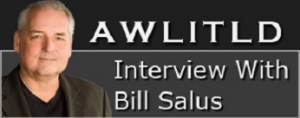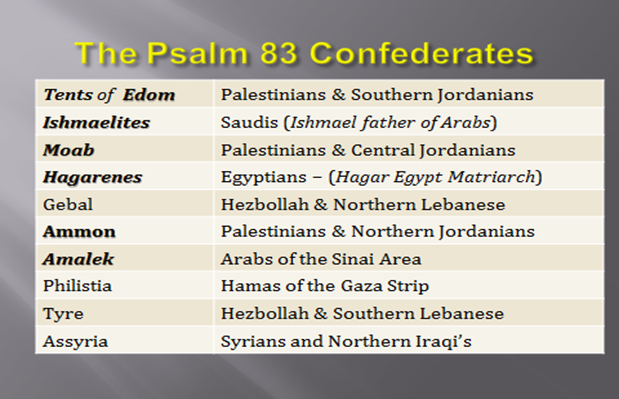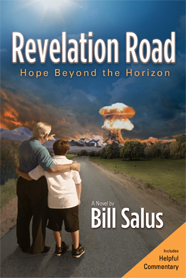Psalm 83, What IT IS, and What it IS NOT – Part One
on Thursday, March 1, 2012 by Bill SalusIn light of today’s turbulent Mideast events, many eschatologists are taking a closer look at Psalm 83. The Psalm seems to predict a war of epic biblical proportion between Israel and the Arab nations, and terrorist populations that surround it. Some scholars, like the highly respected Dr. Mark Hitchcock, believe the Psalm is little more than a prayer of lament. Whereas end time’s experts, like Dr. David Reagan, and Dr. Chuck Missler have come to believe in the hypothesis presented in my books Isralestine, and Revelation Road, which suggests the Psalm is an imminent prophecy to be watching for.
In his new book, Middle East Burning, Dr. Mark Hitchcock writes the following about Psalm 83;
“While I like Bill Salus and appreciate the diligent work he has done in setting forth the thesis for a separate Psalm 83 war, I don’t see a separate Psalm 83 war taking place before the Tribulation occurs. While there will be wars and rumors of wars and nation rising against nation in the end times, I believe Scripture points to two major wars involving Israel during the last days- the Gog of Magog war during the first half of the Tribulation and the battle of Armageddon at the culmination of the Tribulation. The prophets never clearly delineate a war like the one Salus proposes from Psalm 83. If this war plays the central role that Salus alleges it does, one would expect the prophets to have addressed this directly, But that didn’t happen.” (i)
So then; how should the controversial Psalm be treated, as a mere imprecatory prayer that has little to no application to today’s Middle East events, or a powerful pending prophecy that is about to reshape the entire geo-politics of the Promised Land? The 2-part written interview you are about to read sheds light on important details that strongly suggest the latter is the most likely interpretation.
 Part one takes a closer look at many of the details that are often overlooked in Psalm 83, and part two, answers questions about the motivation of Russia in Gog of Magog, and the potential length of time that spans between Psalm 83, and the Magog invasion. Part two, which also addresses the potential placement and dispositions of America and the West during Psalm 83 and Ezekiel 38, can be read here.
Part one takes a closer look at many of the details that are often overlooked in Psalm 83, and part two, answers questions about the motivation of Russia in Gog of Magog, and the potential length of time that spans between Psalm 83, and the Magog invasion. Part two, which also addresses the potential placement and dispositions of America and the West during Psalm 83 and Ezekiel 38, can be read here.
Recently, I was invited to issue a written response to nine timely questions for a Internet interview with “Are We Living in the Last Days.” One extremely relevant question is asked and answered below. The entire interview can be read here.
QUESTION – Bill for those who haven’t heard of Psalm 83, could you briefly describe WHAT IT IS, and WHAT IT IS NOT?
ANSWER-.What it is – Psalm 83 appears to be a 3000-year old prophecy that awaits an imminent fulfillment. The Psalm presages the coming of a climactic, concluding Arab – Israeli war. It involves the nations displayed below. The image identifies the confederates by their ancient names alongside their modern-day equivalents.
Asaph, the Psalm’s author, informs us that this conglomerate of nations and terrorist populations confederate and form a cunning strategy to wipe the Jewish state off the map. Their goal is to dispossess Israel of its Promised Land. If the event were to happen in the near future it would most likely manifest into a massive Arab war against Israel in an attempt to form one last Arab state called Palestine.
 What it is not – Some scholars believe the Psalm is merely an imprecatory prayer, but it appears to be much, much more. It involves ten specific populations that are contemporaries of each other. It is more than a basic list of Israel’s historical enemies like some suggest. Israel had more enemies than those included in Psalm 83:6-8, but the prophet omitted many of them. This suggests that those Arab groups he included are the actual participants of the confederacy.
What it is not – Some scholars believe the Psalm is merely an imprecatory prayer, but it appears to be much, much more. It involves ten specific populations that are contemporaries of each other. It is more than a basic list of Israel’s historical enemies like some suggest. Israel had more enemies than those included in Psalm 83:6-8, but the prophet omitted many of them. This suggests that those Arab groups he included are the actual participants of the confederacy.
Some other proofs evidencing that the Psalm is prophetic, rather than a simple prayer of lament for Israel are listed below.
• Asaph was a Hebrew prophet. The Bible says that Asaph served Israel in a dual capacity: he was a worship leader, and a prophet.
Worship Leader – 1 Chronicles 16:4-5 points out that he was the chief Levite priest appointed by King David “to minister before the Ark of the Lord, and to record, and to thank and praise the Lord God of Israel.”
Seer (Prophet) – 2 Chronicles 29:30 informs that Asaph was a “seer.” The Hebrew word used for seer in this verse is “chozeh,” and it can be translated as a beholder of vision; a prophet. (ii) 1 Chronicles 25:2 further evidences Asaph’s prophetic office by saying that he prophesied under the order of King David. Moreover, all together Asaph wrote at least 12 of the 150 Psalms. He authored Psalms 50, 73, 74, 75, 76, 77, 78, 79, 80, 81, 82, and 83. Although some of the other eleven Psalms present intrinsic prophetic inferences, Psalm 83 is clearly the most prophetic of the group.
• Psalm 83 involves an actual confederacy with specific participants. This point was made earlier, but is worth repeating. A confederacy involves a contemporary group that allies together for a common purpose. This means the ten populations must come together at some specific point in time. Arguably, they have not.
If Asaph describes a contemporary confederacy this means he is not alluding to a chronological assortment of some of Israel’s historical enemies that existed at various interludes of time. This is yet another reason that the Psalm can safely be considered more than an imprecatory prayer of lament.
• The Arab confederacy has specific characteristics. In addition to coming together with one consent (Ps. 83:5), forming a crafty plan with a mandate against Israel (Ps. 83:3-4), and having an apparent motive to take the Promised Land (Ps. 83:12), the Arab coalition of ten have specific characteristics that prove it must be a contemporary confederacy.
Two of the ten populations are described as living in specific conditions at the time the confederacy comes together. Esau’s descendant Edomites are dwelling in “tents,” and those from Tyre are simply “inhabitants.” Additionally, two other populations are apparently in need of military support when the confederacy forms; Moab and Ammon enlist help from Assyria.
The tents of Edom and the Ishmaelites; Moab and the Hagrites; Gebal, Ammon, and Amalek; Philistia with the inhabitants of Tyre; Assyria also has joined with them; They have helped the children of Lot. Selah (Psalm 83:6-8, nkjv; emphasis added).
• The tents of Edom
Edom, Moab, and Ammon occupied the southern, central, and northern portions respectively, of what is today called modern-day Jordan. Throughout most of ancient history these three co-existed in their own distinct territories. This was certainly the case approximately 3000-years ago when Asaph authored Psalm 83. Why did Asaph single the Edomites out as tent-dwellers from this group?
Biblical references to populations residing in “tents of” conditions often identify either refugee conditions or military encampments; as in Zechariah 12:7 and Daniel 11:45. Today, there are Edomite descendants within the ranks of the Palestinian refugees, and the Palestinians have been involved in several military conflicts with the modern-day Jewish state. These facts suggest that Asaph was identifying today’s Palestinian refugees as the “tents of Edom.”
Additionally, the tents of Edom are listed first among all the confederates. Generally when a group is listed first amongst others in the Bible, it implies that group is the key participant of the prophecy. If so, this suggests that their present refugee plight has something to do with formation of the Arab confederacy. Today, all of the Psalm 83 modern-day Arab equivalents are extremely pro-Palestinian. They all seek the formation of a Palestinian state inside the Promised Land.
• The inhabitants of Tyre
Furthermore, why is Philistia listed alongside the “inhabitants of Tyre” in these same passages? Presently, the Hamas terrorist organization turned political party hails from the area of ancient Philistia, i.e., the Gaza. And, the Hezbollah terrorist organization has a strong presence inside the city Tyre. Hezbollah does not possess its own country; rather they are “inhabitants” within the country of Lebanon, and Tyre is an important city within Lebanon. By describing those involved from Tyre as inhabitants, is Asaph perhaps identifying Hezbollah as a non-nation terrorist member inside the Arab confederacy, alongside Lebanon? Both Gebal and Tyre identify the modern-day country of Lebanon in Psalm 83. Asaph didn’t classify Gebal with inhabitants.
• Assyria has helped the children of Lot (Moab and Ammon)
The above passages also inform that Moab and Ammon, “the children of Lot,” need assistance in Psalm 83. Moab and Ammon represent modern-day Jordan as a member of the Arab confederacy, and Assyria likely identifies Syrian and Iraqi participation in the Psalm. Interestingly, the Jordanian Armed Forces of today are the second-weakest world-ranked army among all of the Psalm 83 countries. The list of rankings is: Egypt (#16), Saudi Arabia (#26), Syria (#35), Iraq (#36), Jordan (#43), and Lebanon (#52). (iii) Lebanon is stronger than its ranking suggests because the rating does not include the military might of the Hezbollah. Therefore, Jordan is probably the weakest of all the Psalm 83 members. Since their bitter defeats in the wars against Israel in 1948, 1967, and 1973, the Jordanian Armed Forces primarily function today to protect the existence of the minority ruling Hashemite Kingdom. They are not necessarily prepared to fight alone in a major regional war. If in the near future they get drawn into a regional war of the scope described in Psalm 83, they would likely need assistance from Syria to the north and Iraq to the east.
• Asaph’s petition presents further proof in the prophetic pudding – Psalm 83:9-11 petitions the Lord to empower the Jews to a military victory formatted in the historical precedent of past Israelite wars against the Midianites and the Canaanites. These past wars are detailed in Judges 4 – 8. The fact that these were specific battles, suggests that Psalm 83 will likewise be a specific war.
Moreover, Psalm 83:13-17 pictures descriptive metaphors that imply Asaph is petitioning for a military victory over the Arab confederacy.
• The miraculous timely discovery of Psalm 83 in Ireland – An extra-biblical matter worthy of mentioning, is that during the midpoint of the 34-day Israel – Hezbollah conflict in the summer of 2006, Psalm 83 was miraculously discovered in Ireland. In what was heralded as the “Irish Dead Sea Scroll Discovery,” the Psalm was found opened in place in Irish bog soil. Apparently against all odds, the antiquities’ parchment had survived intact from being buried for approximately 1200-years.
Considering Psalm 83 is the only place within the entire book of Psalms that Israel and Tyre appear together, this is an amazing discovery. The Israel Defense Forces (IDF) were engaged in a war with the “inhabitants of Tyre.” Some might consider this timely discovery coincidental, but I believe it was providential. The Bible contains 66-books 1189-chapters, 150-Psalms, and approximately 31,200-verses, and the odds of discovering a chapter buried for centuries in a bog, and opened in place to a prophetic war involving the IDF and Hezbollah are astronomical.
Some who believe that the Psalm is not prophetic, argue that position because they suggest no other prophets make mention of this war, and that since Psalm 83 doesn’t specify a time for the war like Ezekiel 38:8 does, then the Psalm should probably be discarded as a prophecy.
I disagree that no other prophets reference this war. Many of the populations in Psalm 83:6-8 show up in unfulfilled prophetic conflicts, like the examples below;
• Edom – Ezekiel 25:14, Jeremiah 49:10, and Obadiah 1:18,
• Ammon – Jeremiah 49:2, Zephaniah 2:9, Isaiah 11:14,
• Moab – Zephaniah 2:9, Isaiah 11:14,
• Philistia – Ezekiel 25:15-17, Isaiah 11:14,
• Saudi Arabia – Ezekiel 25:13
• Egypt – Isaiah 19:16-18
 These are just a few examples. In my book Revelation Road Hope Beyond the Horizon, I give many more related instances. I would also mention that it doesn’t appear that any other prophets speak about the prophecy of Ezekiel 38, except perhaps Joel 2:20; but that does not disqualify Ezekiel 38 from being a prophecy?
These are just a few examples. In my book Revelation Road Hope Beyond the Horizon, I give many more related instances. I would also mention that it doesn’t appear that any other prophets speak about the prophecy of Ezekiel 38, except perhaps Joel 2:20; but that does not disqualify Ezekiel 38 from being a prophecy?
In his book Dr. Hitchock also advances the argument that Psalm 83 doesn’t specify the timing of the event. This is another reason he discards the Psalm as being a prophecy. However, the fact that Psalm 83 doesn’t give a specific timing doesn’t bar it from being a bonafide prophecy either. There are several prophecies that don’t present us with specific time periods of fulfillment. A perfect example concerns the prophecies regarding the four Gentile empires in the book of Daniel. Daniel never declared when the Persians would defeat the Babylonians, or the Greeks would defeat the Persians, or the Romans would defeat the Greeks.
Lastly, some say that the Psalms are not prophetic, but Psalm 22 and others seem to refute that theory. Some say Psalm 83 is nothing more than a type of a Psalm 2. However, Psalm 2 doesn’t give a specific list of Israel’s enemies like Psalm 83:6-8 does. Concerning the interpretation of Psalm 2, I recommend the audio teaching of Tony Garland, linked here.
There are many more reasons than these listed above that argue strongly for a prophetic interpretation of Psalm 83 and they are contained in my books called Isralestine and Revelation Road.
_____________
(i) Middle East Burning by Mark Hitchcock, page 167
(ii) Strongs Hebrew and Greek Dictionaries
(iii) World army rankings gathered from the Internet on 2/24/12 at this link: http://www.globalfirepower.com/


